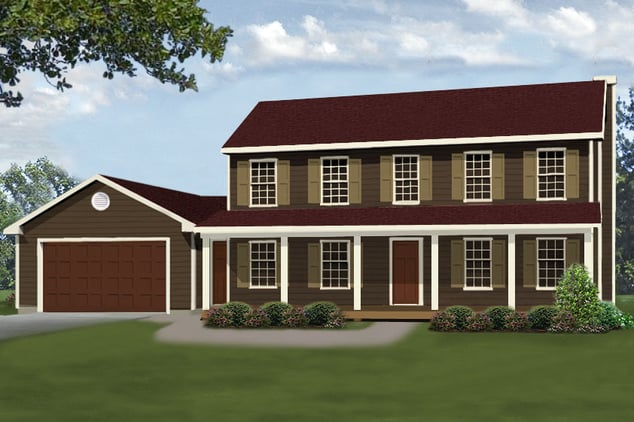
The housing market isn’t making headlines like it did during the pandemic, but in 2025, it’s still not fun to navigate.
Inventory remains low, prices are up, and most homes don’t fit the way people live today. More buyers are stepping away from the chaos and building a custom home instead.
Buying an existing home often means unexpected repairs or awkward spaces that never quite work. It also puts pressure on homeowners to take on updates themselves or live with someone else’s choices. The custom home building process offers a clearer path forward with more:
- Predictability
- Personalization
- Long-term value.
Market conditions will always change, but building a custom home gives people what they want and a home they won’t have to rethink later.
The Value of Building a Custom Home
While constructing a new home isn’t necessarily faster or less expensive than purchasing an existing home, there is a value in building your home that you can’t put a price on.
Moving into a home is a major milestone in life – the kind where you take a picture with your family to remember the moment. Imagine walking into your newly constructed home and already knowing every square inch of it. Imagine the peace of mind of not having to worry about any surprises from the last owner, which can negate any cost savings.
Building a home is a long-term investment – you can rest assured it was constructed using modern materials and to the latest building standards.
Most of all, imagine the sense of pride you’ll have knowing that your home is one you designed to meet all your needs.
The Real Cost of Buying an Existing Home
It might seem like buying an existing home is the easier choice. But even with more listings available in 2025, the real cost often goes far beyond the price tag.
According to April 2025 data, active listings are up over 30% compared to last year, and new listings rose by more than 9%. More homes on the market should be a good thing — but affordability is still a hurdle. The median list price holds steady around $431,000, and the income needed to afford a typical home has jumped nearly $47,000 since 2019. Sellers are starting to respond, with about 1 in 5 listings seeing price cuts.
Even if the price feels right, older homes can come with their own set of problems:
- Aging HVAC, electrical, or plumbing systems that need replacement
- Poor insulation or outdated windows that raise utility costs
- Floor plans that just don’t work for how families live today
These repairs and adjustments add up quickly – and they don’t always solve the deeper issue: the house wasn’t built for you.
2025 Housing Market Forecast
Housing market predictions for 2025 all point to a mixed bag of factors, but an overall positive outlook.
- Mortgage rates: Fannie Mae expects mortgage rates to decline in 2025, potentially settling around 6%. Lower rates could encourage more homeowners to refinance and help jumpstart the existing home sales market. Still, a full return to pre-pandemic sales levels may take time. Affordability challenges, a limited supply of homes that truly meet buyer needs, and unpredictable tariffs are likely to keep the recovery gradual.
- Home sales and prices: Home sales showed signs of recovery heading into 2025, even with continued high mortgage rates. Tight inventory kept prices climbing — home values were up 4.5% year-over-year in October. Freddie Mac expects prices to rise another 2.0% in 2025.
- Home price growth and sales: HousingWire says the housing market has entered a much healthier stage in 2025, with home sales steadily topping 4 million per month. National home prices are expected to grow by about 1.77%, though further gains will likely depend on mortgage rates holding near or below 6%.
- Overall market outlook: The 2025 housing market remains difficult for buyers. Mortgage rates are still high, prices haven’t dropped meaningfully, and inventory is limited in many areas. Even where listings are increasing, the market continues to favor sellers. Without a significant drop in rates, affordability will remain out of reach for many would-be buyers.
Custom Home Building in 2025
The outlook for custom home building in 2025 is complicated. While mortgage rates have edged down slightly, they haven’t fallen far enough to unlock a wave of new demand. Builders are still offering incentives like temporary rate buydowns and closing cost assistance, but those tactics aren’t drawing buyers the way they used to.
Affordability remains a challenge, and new headwinds are adding pressure. Proposed tariffs on Canadian lumber and other building materials could drive up costs again, forcing both builders and buyers to reconsider timelines and budgets. Some builders are already adjusting prices or slowing production to keep inventory moving.
It’s not a freeze, but it’s a shift. For buyers interested in building a custom home, it’s a reminder that planning, flexibility, and trusted guidance matter more than ever.
Building A Custom Home to Make a Better Investment
Choosing your next home is one of the biggest decisions you'll make — and one that shapes how you live every day. Buying may seem quicker, but it often means settling for someone else’s vision.
Building a custom home offers a different path. It’s a chance to start with what matters to you and invest in something built to fit – not just for today, but for the long run.
Interested In Learning More About What It Takes To Build A Custom Home?
Check out our Custom Home Building Guide!



